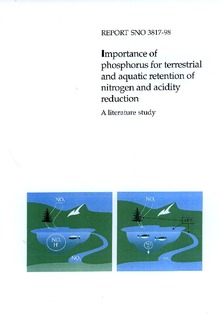| dc.contributor.author | Kaste, Ø. | nb_NO |
| dc.contributor.author | Lyche, A. | nb_NO |
| dc.contributor.author | Wright, R. | nb_NO |
| dc.contributor.author | Brandrud, T.E. | nb_NO |
| dc.contributor.author | Lindstrøm, E.-A. | nb_NO |
| dc.contributor.author | Skiple, A. | nb_NO |
| dc.contributor.author | Bakke, R. | nb_NO |
| dc.contributor.author | Kommedal, R. | nb_NO |
| dc.contributor.other | Kaste, Ø. - Project manager | nb_NO |
| dc.coverage.spatial | Sør-Norge | nb_NO |
| dc.date.accessioned | 2014-08-01T10:42:05Z | |
| dc.date.available | 2014-08-01T10:42:05Z | |
| dc.date.issued | 1998 | nb_NO |
| dc.identifier | 3817 | nb_NO |
| dc.identifier.isbn | 82-577-3395-4 | nb_NO |
| dc.identifier.issn | 1894-7948 | nb_NO |
| dc.identifier.uri | http://hdl.handle.net/11250/209804 | |
| dc.description.abstract | Many catchments in high N-deposition areas have low N retention. It has been hypothesised that under such conditions P addition may increase N retention in both terrestrial and aquatic ecosystems. Fertiliser trials in N-saturated terrestrial ecosystems show that P addition can cause increased plant uptake of N. Few studies, however have focused on N leaching to surface waters. Theoretical considerations and limited empirical data suggest that P addition to acidic, oligotrophic lakes will stimulate NO3 assimilation and thereby increase alkalinity and N retention within the lake. Near-shore coastal waters may benefit from reduced riverine N loading during summer in terms of reduced algal biomass and reduced probability of development of toxic dinoflagellate blooms. P treatment may be suitable to neutralise moderately acidified lakes and streams (pH>5.2). P addition will also increase biodiversity, stimulate aquatic production and improve the resource base for fish production. In more acidic lakes and streams, a combination of liming and moderate P addition may be an optimal management tool. We conclude that a large-scale experiment is necessary to test if P addition (both terrestrial and aquatic) might provide a mitigation technique for areas experiencing high NO3 levels in surface waters. Possible technological solutions on how to use P to increase pH and stimulate biological production in acidified areas have been evaluated. Instead of adding P as PO4 3 salts, P-containing wastewaters can be utilised at relatively low cost, after removing particulate matter, BOD, and N, but not P. | nb_NO |
| dc.description.sponsorship | HYDRO ASA | nb_NO |
| dc.publisher | Norsk institutt for vannforskning | nb_NO |
| dc.relation.ispartofseries | NIVA-rapport;3817 | nb_NO |
| dc.rights | Navngivelse-IkkeKommersiell-DelPåSammeVilkår 3.0 Norge | nb_NO |
| dc.rights.uri | http://creativecommons.org/licenses/by-nc-sa/3.0/no/ | nb_NO |
| dc.subject | sur nedbør | nb_NO |
| dc.title | Importance of phosphorus for terrestrial and aquatic retention of nitrogen and acidity reduction - a literature study | nb_NO |
| dc.type | Research report | nb_NO |
| dc.rights.holder | Norsk institutt for vannforskning/Norwegian institute for water research | nb_NO |
| dc.subject.nsi | VDP::Matematikk og naturvitenskap: 400 | nb_NO |
| dc.source.pagenumber | 50 | nb_NO |
| dc.subject.keyword | nitrogen | nb_NO |
| dc.subject.keyword | fosfor | nb_NO |
| dc.subject.keyword | forsuring | nb_NO |
| dc.subject.keyword | eutrofiering | nb_NO |
| dc.subject.keyword | nitrogen | nb_NO |
| dc.subject.keyword | phosphorus | nb_NO |
| dc.subject.keyword | acidification | nb_NO |
| dc.subject.keyword | eutrophication | nb_NO |
| dc.relation.project | O-97040 | nb_NO |


